Everyday Uses of Smartphones for Modern Productivity

Smartphones are ubiquitous, transforming how people accomplish tasks daily. These devices are not just for communication; individuals, companies, and scholars alike harness their potential for improved productivity. With a few taps, users access various applications tailored to enhance performance, streamline work processes, and foster creative outputs. Whether managing tasks or engaging in on-the-go learning, smartphones provide the tools necessary for efficiency. This article delves into practical smartphone uses that optimize workflow and foster personal and professional growth. Without even realizing it, users carry a powerful productivity tool in their pocket. Devices like the HONOR X7d highlight how modern smartphones integrate versatile features to elevate productivity to new heights.
How Smartphones Have Evolved into Productivity Tools?
Once simply communication devices, smartphones have undergone a radical transformation. Early features like basic text messaging and calls have expanded into sophisticated productivity suites. Innovations such as powerful processors, expanded storage, and high-speed internet capabilities enhance traditional functions. These developments ushered in diverse apps: task managers, schedulers, document editors, and communication platforms that empower users to achieve more. Smartphones integrate seamlessly with cloud services, allowing access to documents, and collaborative tools enhance teamwork, irrespective of geographical constraints. This evolution reflects technology’s role in modern productivity and shifts how individuals and businesses operate, adapting seamlessly to ever-changing environments.
Core Productivity Functions You Can Do on Your Smartphone
Managing Tasks, To-Do Lists & Reminders
Task management applications have revolutionized how users handle daily tasks. Apps like Todoist and Microsoft To Do allow seamless task creation, prioritization, and tracking of deadlines. Users swiftly check off tasks and set reminders to manage their schedules efficiently. With features like recurring tasks and integration with other productivity software, users plan and execute responsibilities with remarkable ease. These applications cater to both personal errands and complex project timelines, making task management an efficient process. The convenience of having these functionalities on a smartphone means productivity is accessible anywhere, reigning over traditional pen-and-paper lists.
Calendar & Scheduling Apps
With calendar and scheduling apps, organizing the day becomes a streamlined process. Google Calendar exemplifies an app that syncs across devices, offering features like event invitations and reminders. Users can allocate time effectively for meetings, personal tasks, and breaks to ensure a balanced schedule. Smart notifications prompt upcoming commitments, reducing the chance of overlooking crucial appointments. These tools emphasize efficiency, allowing professionals to coordinate work and personal commitments seamlessly. The integration with task management and email applications further solidifies calendars as indispensable productivity tools on smartphones.
Email, Messaging & Communication Tools
Smartphones excel at keeping users connected through efficient communication platforms. Email applications like Outlook and Gmail simplify managing correspondence, offering quick response capabilities and organizational features like folders and filters. Messaging apps, including Slack and WhatsApp, support instant communication, conducive to collaborative environments. Video calling features enhance real-time interaction, crucial for virtual meetings. Smartphones enable users to stay connected with colleagues, clients, and family, regardless of physical barriers. Communication tools on smartphones go beyond mere messaging, constructing an integrated environment where productivity flourishes.
See also: Achieving Optimal Oral Aesthetics Through Cutting-Edge Dental Implant Techniques
Extending Productivity Beyond Work Tasks
Learning on the Go
Smartphones facilitate continual learning, which is essential in a fast-paced world. Platforms like Coursera and Duolingo allow users to enroll in courses and explore languages ubiquitously. Podcasts and audiobooks engage listeners during commutes, converting downtime into productive sessions. Applications like TED and YouTube educate and inspire, offering content across diverse topics. Whether mastering new skills or staying updated with industry trends, smartphones are central to an effective learning strategy. Their portability ensures learning materials are within reach, transforming informal moments into opportunities for intellectual growth.
Health & Wellness
Smartphones promote a balanced lifestyle through health and wellness applications. Fitness apps such as MyFitnessPal logged meals and exercise routines, channeling focus into health goals. Meditation apps like Calm offer guided sessions, contributing to mental well-being via relaxation techniques. Sleep trackers and step counters celebrate users’ progress, encouraging sustainable habits. These tools target both physical and mental health, advocating for harmonious living that complements productivity. By integrating wellness into daily routines, smartphones encourage users to live well, enhancing both personal satisfaction and work performance.

Best Practices for Preventing Burnout & Overload
Setting Boundaries: Screen Time & Offline Periods
Though smartphones advance productivity, it is crucial to manage usage to avoid burnout. Setting screen time limits ensures users dedicate time to offline activities, promoting balance. Applications like Digital Wellbeing track usage patterns, providing insights and helping users minimize distractions. More deliberate offline periods, especially during personal time, foster mental clarity and relaxation. Introducing technology-free zones or times encourages social interactions and focuses on physical events. Allowing oneself a break from digital engagements underscores the importance of mindful connectivity. Creating boundaries demonstrates an intentional approach to smartphone use, preventing excessive reliance and fostering overall well-being.
Organising Your Phone
Efficiency on smartphones starts with organized apps and files. Eliminating redundant applications and arranging them in folders streamlines access and reduces clutter. Regularly cleaning the cache and archiving old files preserves memory space, enhancing device functionality. Customizing notifications and organizing widgets allows an environment tailored to individual productivity preferences. By fostering neatness, users discover the most efficient routes to apps without unnecessary distractions. These practices promote a system where users interact mindfully with their devices, optimizing both time and productivity in personal and professional spheres.
Conclusion
Smartphones are indispensable productivity tools, offering versatile solutions to everyday tasks. Their evolution has transformed communication into powerful, multifunctional devices with applications that span task management, learning, and wellness. Preemptively addressing burnout and overload through careful management amplifies their benefits. Best practices, such as organizing phone environments and setting boundaries, maximize smartphone utility. Utilizing these devices efficiently propels users towards enhanced productivity, be it for personal goals or collaborative projects. Smartphones encapsulate a spectrum of functionalities, equipping users to navigate daily demands effectively. Your smartphone is indeed a valuable ally in achieving productivity goals effortlessly.





